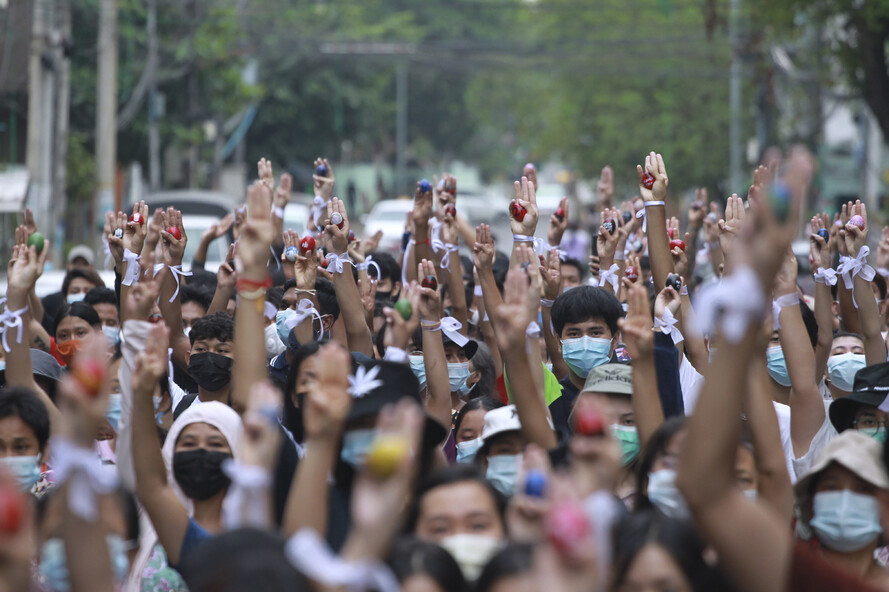On the 4th in Yangon, Myanmar’s largest city, protesters hold colored Easter eggs and salute three fingers, expressing their willingness to resist the military coup. AP/Yonhap News
Seoul elementary, middle, and high school students have a time to discuss the protests for democratization in Myanmar, where more than 550 people died due to violent crackdown on citizens who resisted the military coup. On the 6th, the Seoul Metropolitan Office of Education announced on the 6th that it will produce an instrumental education material titled’Waiting for the Spring of Myanmar’ and distribute it to the school site. The aim is to help students develop a sense of respect and solidarity for global citizenship based on diversity, human rights, and peace sensibility while discussing social issues centering on the Myanmar crisis. Occasionally class (education) refers to classes conducted to help students understand correct educationally meaningful topics or social issues regardless of the official curriculum. It is not compulsory education, and may be conducted at the discretion of the teacher with prior approval from the principal after review by the curriculum council and the school curriculum committee. Earlier, the Incheon Metropolitan Office of Education also announced on the 31st of last month that it is developing instrumental education materials under the theme of’Myanmar and democracy’. Seoul Superintendent Cho Hee-yeon said on the day, “Through this Myanmar instrumental class, students will be able to learn in depth how individual practices can affect society as a whole by understanding the multilayeredness of civic movements from a critical point of view.” .
‘Waiting for the Spring of Myanmar’ instrumental training materials distributed by the Seoul Metropolitan Office of Education
All the learning materials written by incumbent teachers are in 4th round. In the first poem with the theme of’Myanmar and My Connection’, we examine the location and history of Myanmar, international relations, and exchanges with Korea, and find out what is the connection between oneself and Myanmar. In the second poem under the theme of’Brave Citizens of Myanmar’, students learn about’Tamein’, a traditional skirt worn by Myanmar women, and various protest movements of citizens. In Myanmar, there is a long-standing belief that passing under this skirt loses power, and citizens hung skirts at the entrances of villages to prevent suppression of the military and police and to protect protesters. In the 3rd session (‘Keeping peace in everyday life) and the 4th session (‘There is an elephant in the room’), you share your thoughts on the Myanmar crisis and reflect on the situation of Rohingya refugees and citizens in Myanmar. Learning materials, consisting of PPT, workbook, and teacher’s guide, are provided at the level of elementary school students, middle and high school students, and special classes and elementary school students. In particular, for the 3rd session, materials for special school students and Chinese and English translations for multicultural students are provided separately. Teachers can freely select and use materials according to the level of individual students, regardless of school level. Myanmar opportunity classes can be conducted using creative experiences, clubs, related subjects, elective courses, and class time. The author emphasized, “When dealing with stories about oppression and violence, it is most important to have a conversation in a’safe atmosphere for everyone’, considering students with trauma.” By Lee Yoo-jin, staff reporter
newsletter
Every morning, every Thursday day
A friendly newsletter that will save you from the flood of news.
Meet
